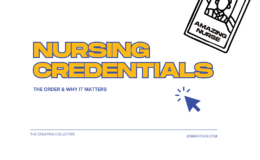This is part four of the Nursing Research Challenge. While this article is not a research article, as a case study, it is a form of evidence.
The Article: Stefancyk, A. (2009). Transforming care at the bedside: One-hour, off-unit meal breaks. American Journal of Nursing, 109(1): 64-66.
The Big Idea: Nurses rarely eat or take full breaks, and when they do break for lunch, food is eaten quickly and the break is constantly interrupted by phone calls, overhead pages, and patient calls. In addition to staff satisfaction, decreased or lack of break times can result in exhaustion and, ultimately, errors. One unit decided to change the way their day-shift nurses (who work 12-hour shifts) eat lunch by implementing one-hour, off-unit meal times via Transforming Care at the Bedside (TCAB)* initiative. Typically eight nurses worked on a shift, so two lunch breaks were scheduled with four nurses attending each lunch break. Nurses rounded on patients immediately before leaving for lunch and then handed patients over to the other respective nurses. When that group returned, the other group proceeded similarly. In addition, the unit used positive peer-pressure to get all nurses to take their two fifteen minute breaks throughout the day.
Survey Says!: Surprisingly, nurses were very reluctant to take one-hour meal breaks off the unit, worrying about patients and lack of time to finish everything in a day. However, the entire unit agreed to work the project in its entirety for one to two weeks and see how it worked. All it took was one full lunch off the unit for nurses to realize the benefits to themselves and their care. Nurses’ spouses even came and ate lunch with them, and one time the group of four nurses ate outside on the hospital lawn, using the time to socialize and enjoy the day. The article reports nurses never miss their lunch now, and they look forward to the time. While the project data is currently being formally reviewed, the unit says they know of no incidences in which the one-hour, off-unit lunches negatively impacted patient care or communication with the healthcare team. To boot, the unit is quieter during the lunch breaks, possibly because nurses round on patients immediately before leaving the unit, taking care of any pressing needs.
Quotable: “This change…required a shift in the culture, and it didn’t happen overnight. Surprisingly, our biggest barrier wasn’t finding coverage for patient care but rather the nurses’ own reluctance to take an hour-long break. Overcoming that resistance wasn’t easy.”
“We used the weekly TCAB meetings to conduct our focus group discussion about the change…The nurses talked about feeling as if they were just arriving for the day, refreshed and ready to go, when they stepped off the elevator upon returning from their meal.”
“The feedback at the TCAB meetings also validated our predicted outcomes: the nurses reported feeling refreshed and less fatigued, enjoying increased teamwork and familiarity with their colleagues, and having improved time-management skills.”
So What?: This article was fascinating. It is a short read, so if you have a moment, definitely click on the link. This is a great example of how nurses at the bedside can positively impact their own practice and lives. Maybe you should print the article and suggest a similar idea to your facility?
You can read an entire TCAB article series (for free!) at AJN.







tsalerno
March 6, 2011 10:58 amAs part of TCAB Initiative is there an accessment on the impact from Best Bediside Practices on Patient Falls, HAIs, Med Errors, AEs which includes the following practices: AIDET, Bedside Change of Shift Reporting, Power Minutes at the Change of Shift, Hourly Rounding, Red Team Approach to Bedside Patient Safety and Compliance, and SBAR-R as we are using at our hospital?
nursetopia
March 13, 2011 10:26 amHi, tsalerno. I realize I never responded to you. Apologies. I am not certain if there is an evaluation of those items. The best place to check, for sure, would be the TCAB website. Way to take those steps in your facility!